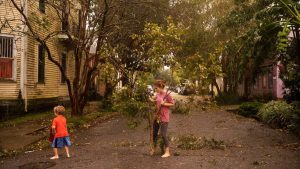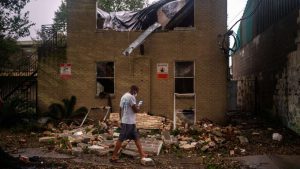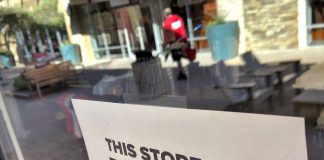OCTOBER 29, 2020

Officials said Zeta destroyed many structures and downed more than 200 trees. – Edmund D. Fountain / NY Times
The storm is cutting off electricity all along its path.
Hundreds of thousands of people were without electricity in states across the South on Thursday as Hurricane Zeta barraged through the region with powerful winds, shredding homes and businesses and knocking down trees.
The storm moved quickly, making landfall on the Louisiana coast as a Category 2 hurricane on Wednesday afternoon. Before the night was over, officials on the coast had already begun assessing the extent of the damage and deploying workers to begin restoring power.
But by Thursday morning, about 400,000 customers in Louisiana were without electricity, according to Entergy Louisiana, while at least 600,000 across Georgia, 494,000 in Alabama, 277,000 across North Carolina and more than 83,000 in Mississippi were also without power.
Zeta had weakened into a tropical storm with maximum sustained winds of 60 miles per hour, and was about 50 miles west of Asheville, N.C., by 8 a.m. Eastern time. Zeta was forecast to make its way to the Mid-Atlantic states by the afternoon and then out into the Atlantic Ocean by the night, producing as much as three inches of rain across the area.

The roof of a New Orleans apartment building collapsed during Zeta’s high winds. – Kathleen Flynn/Reuters
Zeta had slammed coastal areas with several feet of storm surge, but much of its wrath came from powerful winds. In New Orleans, the storm left behind a dark city. Local journalists shared images on social media showing the French Quarter devoid of light and life. The storm also unleashed floods in Louisiana and Mississippi.
“We definitely made it through,” Mayor LaToya Cantrell said during a briefing on Wednesday night.
Three people have died, as officials warned of continued danger.
At least three deaths have been attributed to the storm. The authorities said a man was electrocuted by a downed power line in Louisiana on Wednesday while another man had presumably drowned in Biloxi, Miss., late that night. And early Thursday a man died in Cherokee County, Ga., when a tree fell onto a mobile home.
In New Orleans, Mayor LaToya Cantrell also reported a person injured when a nearby building collapsed. Trees and debris blocked many streets, particularly the large thoroughfares known for their canopies of live oak trees.
Hurricane Zeta moved swiftly through the South, but officials warned residents not to venture out too quickly on Thursday. “Please, leave it up — please, leave it up — to public safety officials to manage the damage caused by Hurricane Zeta,” Ms. Cantrell said. “We do not want to lose another life. It is unnecessary.”
Zeta pounded a region that had been left hobbled and exhausted by a long and punishing season that has been one of the most active in more than a decade. It was the fifth named storm to hit Louisiana this year, and the 27th so far in the Atlantic season.
The storm intensified in strength in the final hours before landfall, nearly growing into a Category 3 storm. Yet the region benefited from Zeta’s rapid pace of roughly 20 m.p.h., which meant the communities in its path were spared from the deluges delivered by previous storms that had been much more sluggish.
Zeta made landfall around 4 p.m. local time in Cocodrie, La., a tiny fishing village in the constellation of coastal islands southwest of New Orleans in Terrebonne Parish. It then pushed northeast toward New Orleans, where the authorities said that by late Wednesday there were already reports of more than 200 downed trees.
‘It could have been worse,’ the mayor of hurricane-scarred New Orleans said.
Even with significant power outages and downed trees, officials and residents in Louisiana expressed gratitude Thursday that Hurricane Zeta’s wrath wasn’t more punishing.
“Please be patient,” said Mayor LaToya Cantrell of New Orleans. “It could have been worse.”
Though there had been concerns about the city’s aging municipal drainage system, it was able to keep up with the rainfall’s inch-an-hour pace. Some of the lift stations used to move sewage had failed “in a variety of places,” said Ramsey Green, the city’s deputy chief administrative officer for infrastructure and operations, who told residents to expect to see the agency’s “loud yellow vehicles” working in manholes around town, providing power to failed lift stations.
Crews who had weathered the storm at the city’s Department of Parks and Parkways rolled out in trucks as soon as the winds died down, clearing meandering paths one-car wide through piles of greenery along Gentilly Boulevard and other tree-lined streets. Still, Mr. Green said, “There’s a ton of vegetation in the streets right now” and it would take time to clear.
Many residents sat outside after the storm, enjoying the 70-degree weather and checking on neighbors. But almost nothing commercial was open. Nearly all of the businesses that are the lifeblood of urban nightlife — gas stations, fast-food joints, mini-marts, bars — were closed.
On Royal Street in the Ninth Ward, Benny Naghi and his staff used flashlights to usher customers through his store, Mardi Gras Zone. He wanted to stay open, to serve his community, but he could only take cash, because his credit-card and cash machines had no electricity. That will continue until the bucket trucks and powerline repair crews are able to repair blown transformers and lines downed by Zeta’s high winds.
A few miles away, near where Elysian Fields Avenue meets Interstate 610, the bright lights of Brother’s Food Mart, powered by generators, were a bright beacon for the surrounding area. Its parking lot was jam-packed and lines of people had stretched out the door all through the night, as customers came to pump gas, use the store’s A.T.M., and buy groceries and cigarettes, said a clerk, Raad Assabahi, on Thursday morning.
“Everyone else was closed, we only were open,” Mr. Assabahi said. “And we haven’t stopped.”
Courtesy/Source: NY Times










































































































